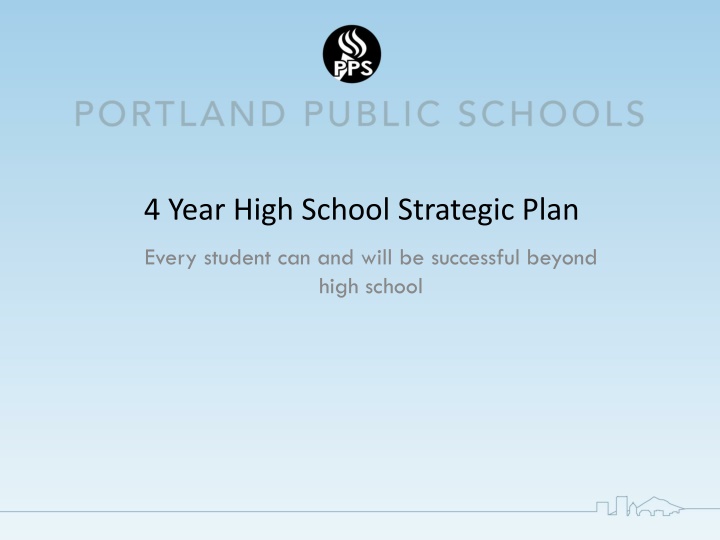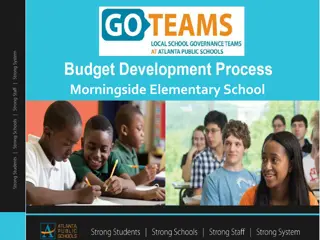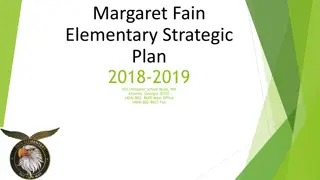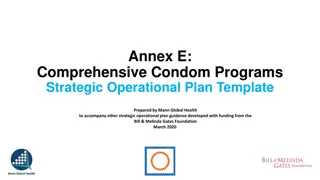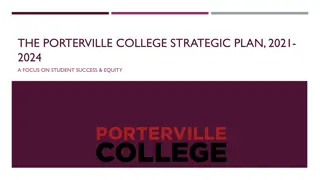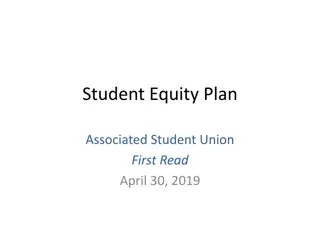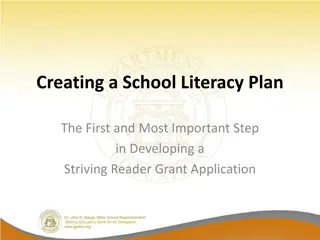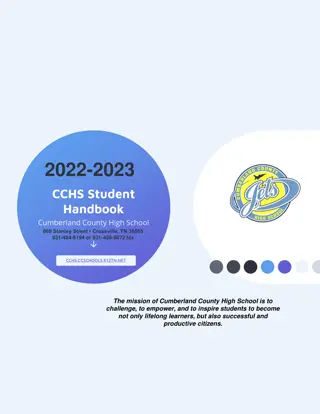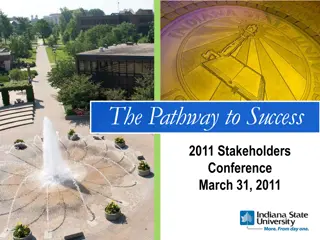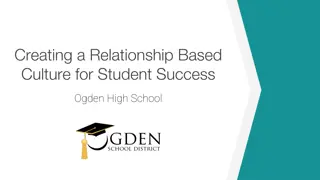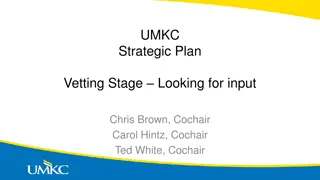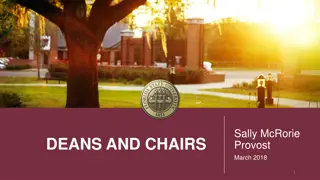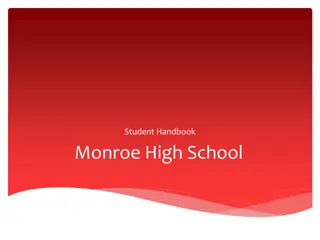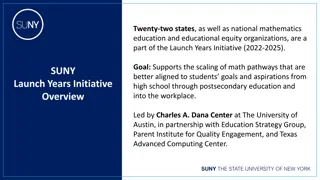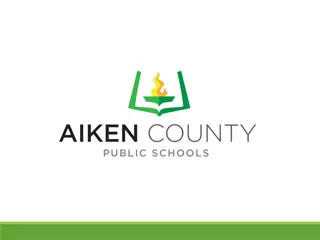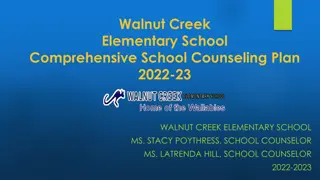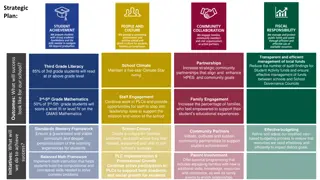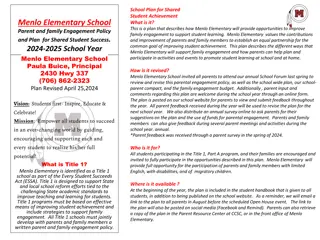Comprehensive High School Strategic Plan for Student Success
This comprehensive high school strategic plan focuses on ensuring every student achieves success beyond high school by aligning with district mission, implementing supports for student engagement, and promoting college and career readiness. The plan aims to increase graduation rates, postsecondary enrollment, and student engagement through culturally relevant pedagogy and a multi-tiered support system. Notable strategic shifts include emphasizing culturally relevant curriculum, expanding CTE programs, and enhancing academic core programs.
Download Presentation

Please find below an Image/Link to download the presentation.
The content on the website is provided AS IS for your information and personal use only. It may not be sold, licensed, or shared on other websites without obtaining consent from the author.If you encounter any issues during the download, it is possible that the publisher has removed the file from their server.
You are allowed to download the files provided on this website for personal or commercial use, subject to the condition that they are used lawfully. All files are the property of their respective owners.
The content on the website is provided AS IS for your information and personal use only. It may not be sold, licensed, or shared on other websites without obtaining consent from the author.
E N D
Presentation Transcript
4 Year High School Strategic Plan Every student can and will be successful beyond high school
What we are building 1 2 3 A 4-Year strategic plan for high schools & an accompanying annual action plan Plan that aligns and compliments High School Success (Measure 98) while adhering to PPS context Scope: College & Career Readiness in the context of high school students High School Strategic Plan
Plan is Aligned to District Mission Every student by name is prepared for college, career and participation as an active community member, regardless of race, income or zip code.
HS Plan is aligned with existing policies and frameworks Successful Schools Framework Racial Educational Equity Policy Drives steadfast focus on racial equity Organizes work around set of research- based qualities that all successful schools demonstrate
High School Strategic Plan Contains 3 Goals DESIRED OUTCOMES Increased graduation and completion rates Increased postsecondary enrollment Increased student engagement 1. Design a comprehensive college and career readiness system to prepares students for postsecondary options and careers. 2. Deliver culturally relevant pedagogy & curriculum to accelerate academic achievement and personal growth with a focus on historically underserved students. 3. Implement a multi-tiered system of supports for student engagement that sounds the alarm sooner for students at risk of dropping out and not being ready for postsecondary success. Eliminate opportunity gaps for historically underserved students for all of the above*
Notable Strategic Shifts From a focus on: To a focus on: Instruction: culturally relevant pedagogy curriculum and opportunity Structure, including size of schools, boundaries and facilities End game = post-secondary preparedness High School graduation and completion Ensuring CTE programs are high quality Expanding CTE programs Guaranteeing academic core plus strong socio-emotional core supports Guaranteeing basic core academic program in all comprehensive schools Boosting credits earned in AP/IB & DC among all students, especially historically underserved students Boosting enrollment in AP/IB and DC programs among all students, especially historically underserved students
4 Year Strategic Plan Goals - PPS High Schools COLLEGE & CAREER READINESS CULTURALLY RELEVANT PEDAGOGY & CURRICULUM STUDENT ENGAGEMENT Prepare students for college and career Provide historically underserved students with rigorous, culturally responsive, and engaging learning environments 4 Year Supporting Strategies Implement a multi-tiered system of support 2. Improve 9th Grade PLCs (M98) 1. Implement Culturally Relevant Pedagogy & Curriculum 3. Enhance CTE Quality & Sustain Programs (M98) Implement proficiency based teaching & learning (PBTL) within Algebra & Physics Provide differentiated PD for assessment literacy Refine district policies to support PBTL Redesign 9-12 report card Identify and eliminate bias in curriculum Schedule ELL & SPED students for on-time graduation Implement with structured protocols Build master schedules that support PLCs Leverage and embed CARE into PLCs Use student data to effectively support PLCs Attract & retain CTE teachers Provide resources to sustain programs Communicate CTE programming Evaluate CTE programs for quality Provide instructional support and professional development 4. Improve School Climate & Reduce Chronic Absenteeism (M98) 5. Prepare all students for Postsecondary success (M98) 6. Improve central office responsiveness Implement PBIS Refine school climate plans Review drug & alcohol policies Provide socio-emotional core program IT systems to track interventions Root cause analysis on absenteeism Assign students to advanced courses equitably Students graduate w/ an informed plan Increase CTE, DC, AP and IB enrollment & retention Continue current work with AVID, Advanced Scholars and FAFSA completion Enhance 9th grade exploration course Establish 8th Grade College & Career Experience Improve responsiveness to schools Implement communication protocols Provide consistent forums to incorporate HS principal input Evaluate HS plan Engage families as true partners
Use HS Success (M98) as a launching point for implementing HS Strategic Plan HS Success (Measure 98) Aligns with HS Strategic Plan 1. Culturally responsive pedagogy 2. Improve 9th grade PLCs 3. Enhance quality & sustain CTE programs 4. Improve school climate & reduce chronic absenteeism 5. Prepare all students for postsecondary success 6. Central Office responsiveness Why? 1. Research-based 2. Resources attached ~$6 million per year 3. Allows us to leverage existing work 4.Aligns HS Success with HS Strategic Plan Career & Technical Education (CTE) Student Engagement (Dropout Prevention) College Access
HS Success (M98) History Timeline June - July 2017 Measure 98 Steering Committee HS Principal Feedback Focus Groups Rules Updated Submitted application to ODE 2 Day HS Principal Retreat Preliminary Funding 3 Yr HS Strategic Plan Draft Jan - April 2017
High School Success M98 Background Approved by voters Nov 2016 3 areas required by ODE for district investment: College Level Educational Opportunities CTE Dropout Prevention Establish or expand career and technical education programs in high schools Establish or expand college level education opportunities for high school students Establish or expand dropout prevention in high schools Source: ODE: http://www.oregon.gov/ode/learning-options/CTE/statefund/Pages/Measure98.aspx
High School Success (M98) Eligibility Requirements 9th Grade PLCs Review students grades, absences and discipline by school and by course Develop strategies to ensure at-risk students stay on track to graduate Chronic Absenteeism Plan Implement district-wide, evidence-based practices for reducing chronic absenteeism in grades 9-12 Advanced Course Assignment System Establish multiple measures of academic qualifications indicating academic readiness in assigning students to AP, IB, dual credit & CTE On Track to Graduate System Implement systems to ensure that all HS students, including English Language Learners and Special Education Students, are taking courses required for on-time graduation Partnerships Engage families, community organizations, businesses & postsecondary institutions that inform the plan and support the overall goals Source: ODE: http://www.oregon.gov/ode/learning-options/CTE/statefund/Pages/Measure98.aspx
High School Success (M98) Funding 2017-18 PLANNING YEAR ODE Preliminary allocation (49%): $5,991,590.07 2018-19 ODE Preliminary allocation (51%): $6,236,144.77 Carries over unspent funds from year one to year two Allocation source: ODE: http://www.oregon.gov/ode/learning-options/CTE/statefund/Pages/Measure98.aspx
Implementation Thoughts on Next Steps
Implementation Planning To Dos 1. Urgent - NOW Hiring staff Meeting eligibility requirements Establishing evaluation metrics Establishing systems to support and track implementation Establishing focus groups, workgroups, steering committee 2. First Year Planning - END OF JANUARY Gathering baseline data Establishing implementation plan Identifying stakeholders and partners for planning 3. Planning over 4 years- END OF MARCH Using baseline to inform next steps Engaging stakeholders through focus groups, workgroups, steering committee
Factors Activities Outputs Long-Term Outcomes Short-Term Outcomes Mid-Term Outcomes Impact College Level Coursework SMART Goal Prepare all students for post-secondary success Indicator: % increase in student enrollment in college level coursework Design a comprehensive college and career readiness system Enhance CTE quality and sustain programs Measure 98 baseline data Changes in knowledge, attitude, skills, and beliefs CTE SMART Goal Eliminate the opportunity gap for historically underserved students Indicator: % increase in student completion of at least 2.0 CTE credits What will these activities produce? Implement culturally relevant pedagogy and curriculum Examples: Students are more aware of the benefits of CTE and college level coursework Focus Groups Examples: # students enrolled in CTE, # times teachers are meeting to review student-level data Deliver culturally relevant pedagogy & curriculum Improve 9th grade PLCS NEED SMART GOAL Teachers are more committed to reviewing student- level data All PPS students are graduating from high school prepared for college and career Root-cause and gap analysis Improve school climate and reduce chronic absenteeism Dropout Prevention SMART Goal Implement a multi- tiered system of supports for student engagement Indicator: % growth of 4 and 5 year graduation rates Improve central office responsiveness
Key Historical Lessons Build in adequate time for work to take hold Important to have a plan to act as guide post; you can build towards the plan over time. Alignment to resources to a plan There has been a strong focus on structure as opposed to instruction at the highest levels; time to focus on instruction? Need to measure impact so we know why progress has or hasn t been made.
QUESTIONS? Carla Gay, MSW Director of Early Response Systems & HS Success (M98) Implementation cgay@pps.net 503-916-3527
